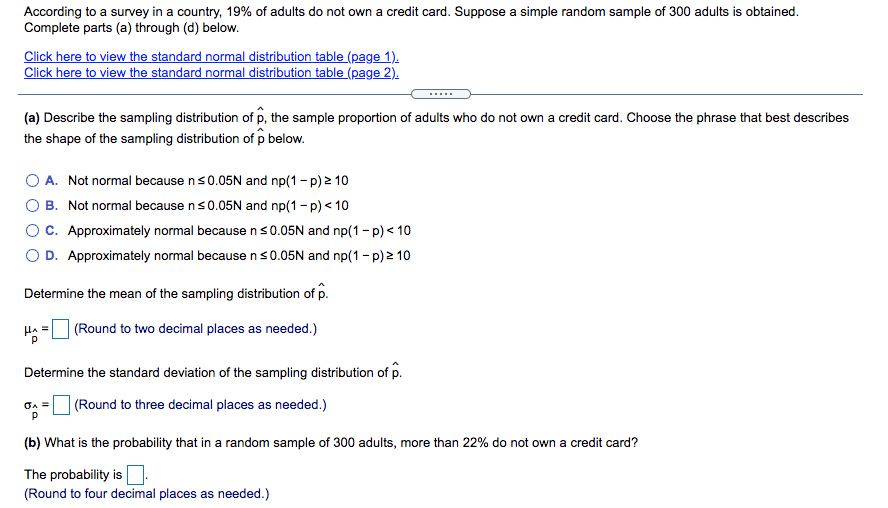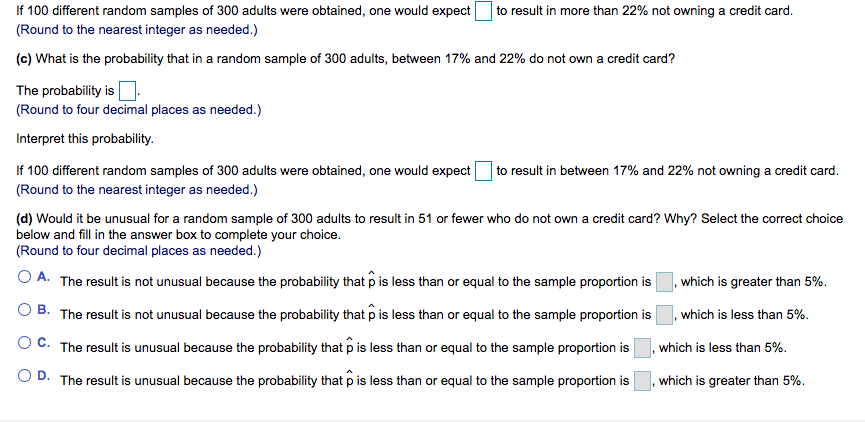(a) Describe the sampling distribution of p, the sample proportion of adults who do not own a credit card. Choose the phrase that best describes the shape of the sampling distribution of p below. O A. Not normal because ns0.05N and np(1- p) 2 10 B. Not normal because ns0.05N and np(1 – p) < 10 C. Approximately normal because ns0.05N and np(1- p) < 10 O D. Approximately normal because ns0.05N and np(1- p) 2 10 Determine the mean of the sampling distribution of p. | (Round to two decimal places as needed.) Determine the standard deviation of the sampling distribution of p. | (Round to three decimal places as needed.) (b) What is the probability that in a random sample of 300 adults, more than 22% do not own a credit card? The probability is . (Round to four decimal places as needed.)
(a) Describe the sampling distribution of p, the sample proportion of adults who do not own a credit card. Choose the phrase that best describes the shape of the sampling distribution of p below. O A. Not normal because ns0.05N and np(1- p) 2 10 B. Not normal because ns0.05N and np(1 – p) < 10 C. Approximately normal because ns0.05N and np(1- p) < 10 O D. Approximately normal because ns0.05N and np(1- p) 2 10 Determine the mean of the sampling distribution of p. | (Round to two decimal places as needed.) Determine the standard deviation of the sampling distribution of p. | (Round to three decimal places as needed.) (b) What is the probability that in a random sample of 300 adults, more than 22% do not own a credit card? The probability is . (Round to four decimal places as needed.)
Glencoe Algebra 1, Student Edition, 9780079039897, 0079039898, 2018
18th Edition
ISBN:9780079039897
Author:Carter
Publisher:Carter
Chapter10: Statistics
Section10.4: Distributions Of Data
Problem 19PFA
Related questions
Question
Question 7: a, b, c, and d.

Transcribed Image Text:According to a survey in a country, 19% of adults do not own a credit card. Suppose a simple random sample of 300 adults is obtained.
Complete parts (a) through (d) below.
Click here to view the standard normal distribution table (page 1).
Click here to view the standard normal distribution table (page 2).
.....
(a) Describe the sampling distribution of p, the sample proportion of adults who do not own a credit card. Choose the phrase that best describes
the shape of the sampling distribution of p below.
A. Not normal because ns0.05N and np(1- p) 2 10
O B. Not normal because ns0.05N and np(1 - p) < 10
OC. Approximately normal because ns0.05N and np(1 - p) < 10
O D. Approximately normal because ns0.05N and np(1 - p) 2 10
Determine the mean of the sampling distribution of p.
(Round to two decimal places as needed.)
Determine the standard deviation of the sampling distribution of p.
| (Round to three decimal places as needed.)
(b) What is the probability that in a random sample of 300 adults, more than 22% do not own a credit card?
The probability is
(Round to four decimal places as needed.)

Transcribed Image Text:If 100 different random samples of 300 adults were obtained, one would expect
(Round to the nearest integer as needed.)
to result in more than 22% not owning a credit card.
(c) What is the probability that in a random sample of 300 adults, between 17% and 22% do not own a credit card?
The probability is:
(Round to four decimal places as needed.)
Interpret this probability.
If 100 different random samples of 300 adults were obtained, one would expect
to result in between 17% and 22% not owning a credit card.
(Round to the nearest integer as needed.)
(d) Would it be unusual for a random sample of 300 adults to result in 51 or fewer who do not own a credit card? Why? Select the correct choice
below and fill in the answer box to complete your choice.
(Round to four decimal places as needed.)
O A. The result is not unusual because the probability that p is less than or equal to the sample proportion is
, which is greater than 5%.
O B. The result is not unusual because the probability that p is less than or equal to the sample proportion is
, which is less than 5%.
O C. The result is unusual because the probability that p is less than or equal to the sample proportion is
which is less than 5%.
O D. The result is unusual because the probability that p is less than or equal to the sample proportion is
which is greater than 5%.
Expert Solution
This question has been solved!
Explore an expertly crafted, step-by-step solution for a thorough understanding of key concepts.
This is a popular solution!
Trending now
This is a popular solution!
Step by step
Solved in 2 steps with 1 images

Recommended textbooks for you

Glencoe Algebra 1, Student Edition, 9780079039897…
Algebra
ISBN:
9780079039897
Author:
Carter
Publisher:
McGraw Hill

Glencoe Algebra 1, Student Edition, 9780079039897…
Algebra
ISBN:
9780079039897
Author:
Carter
Publisher:
McGraw Hill